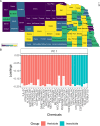Exploring the Joint Association Between Agrichemical Mixtures and Pediatric Cancer
- PMID: 39944898
- PMCID: PMC11815328
- DOI: 10.1029/2024GH001236
Exploring the Joint Association Between Agrichemical Mixtures and Pediatric Cancer
Abstract
Nebraska's age-adjusted incidence rates for childhood cancers are among the highest in the US. Previous studies indicated associations between agrichemical exposures (atrazine and nitrates) and pediatric cancer rate, assuming single pollutant exposure. We evaluated the joint association between the agricultural mixture and pediatric cancer. Agrichemical exposures at a county scale were quantified using the USGS Pesticide National Synthesis Project for frequently applied pesticides from 1992 to 2014 in 93 Nebraska counties. Outcomes were quantified using pediatric cancer diagnosed among children <20 years of age (1992-2014) from the Nebraska cancer registry. We adjusted for social vulnerability factors such as race, income, employment, and access to care. The associations between 32 agrichemicals and cancer subtypes were assessed using the Generalized Weighted Quantile Sum Regression (gWQS) model. The model was fit assuming a Poisson distribution and using the pediatric population as an offset-term and social vulnerability factors as covariates. We observed a statistically significant positive association between the 32 agrichemicals and overall pediatric cancer and subtypes. The strength of associations was slightly stronger among brain and CNS cancers (β = 0.36, CI = 0.14, 0.57) compared to overall cancer (β = 0.30, CI = 0.16, 0.44) and leukemia (β = 0.23, CI = 0.09, 0.38). Dicamba, glyphosate, paraquat, quizalofop, triasulfuron, and tefluthrin largely contributed to the joint association. These findings may explain the joint associations of the agrichemical mixture on childhood cancer. Alternative biomarker-based approaches to measuring human exposure are worth investigating for chemicals of concern, particularly in counties with high agrichemical and cancer rates.
Keywords: environmental mixtures; pediatric cancer; pesticides; rural health.
© 2025 The Author(s). GeoHealth published by Wiley Periodicals LLC on behalf of American Geophysical Union.
Conflict of interest statement
The authors declare no conflicts of interest relevant to this study.
Figures



References
-
- Almasri, H. , Tavares, D. A. , Pioz, M. , Sené, D. , Tchamitchian, S. , Cousin, M. , et al. (2020). Mixtures of an insecticide, a fungicide and a herbicide induce high toxicities and systemic physiological disturbances in winter Apis mellifera honey bees. Ecotoxicology and Environmental Safety, 203, 111013. 10.1016/j.ecoenv.2020.111013 - DOI - PubMed
-
- Andersen, H. R. , David, A. , Freire, C. , Fernández, M. F. , D'Cruz, S. C. , Reina‐Pérez, I. , et al. (2022). Pyrethroids and developmental neurotoxicity ‐ A critical review of epidemiological studies and supporting mechanistic evidence. Environmental Research, 214(Pt 2), 113935. 10.1016/j.envres.2022.113935 - DOI - PubMed
-
- Bailey, H. D. , Infante‐Rivard, C. , Metayer, C. , Clavel, J. , Lightfoot, T. , Kaatsch, P. , et al. (2015). Home pesticide exposures and risk of childhood leukemia: Findings from the childhood leukemia international consortium. International Journal of Cancer, 137(11), 2644–2663. 10.1002/ijc.29631 - DOI - PMC - PubMed
LinkOut - more resources
Full Text Sources
